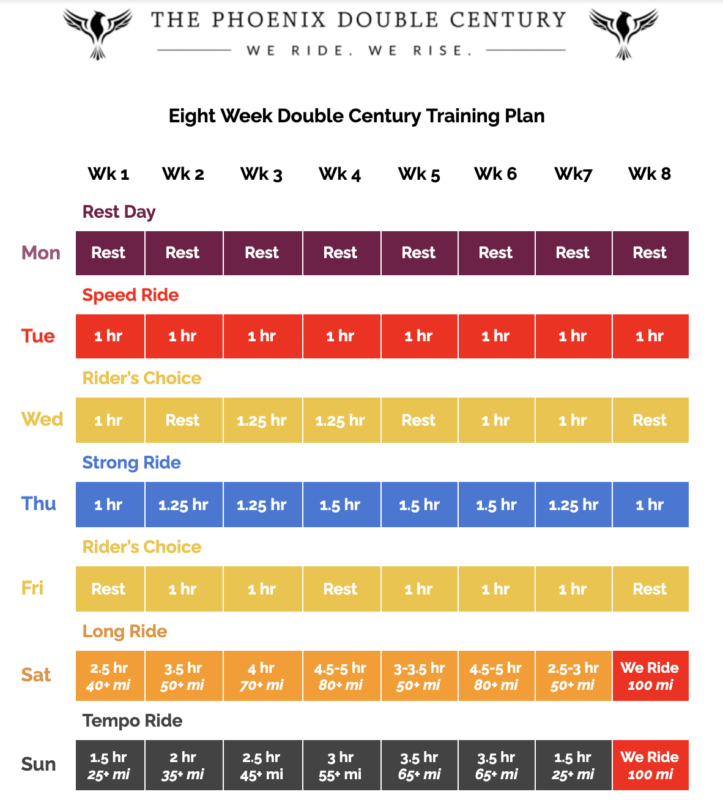
OMG, the Double Century Challenge is Happening!
Riding 200 miles in two days is the perfect way to jumpstart your fitness for the year and challenge your limits. With this progressive, balanced plan you’ll not only more than accomplish your goal, but you will feel great afterward. Your rides can be done outdoors (be safe and always ride with a helmet), or indoors on a trainer.
Read on for details or sign up for the Phoenix Challenge newsletter and get the complete PDF.
Above all else, remember to listen to your body during your workouts. If a recommended workout is too intense, or too many miles, scale it back to meet your body’s needs. And, if you feel like you can do more, feel free to add mileage or extend your workout(s) as needed.
This entire program will have you logging more than 200 miles per week by the end of your eight-week plan. Talk about an accomplishment! If by the final week of your training, you feel ready to tackle the full Double Century (200-mile) ride on the weekend, go for it!
Remember you can check in on the Phoenix Challenge Ride and all of the Double Century resources on the website: www.weridewerise.com and our Strava Club: www.strava.com/clubs/we-ride-we-rise
Get Fitter Faster
You have a lot of ground to cover to get ready, so traditional approaches won’t really suit our timeline. Instead, we need to be creative and use intensity and stacked workout days (for example) to build your fitness quickly and effectively.
You’ll still need to factor in rest and room to have fun in your training — recruit your friends! — because finding a balance to all this “work” is critical.
Let’s dive in…
Workout Specifics
Tuesday Speed Ride (Your Secret Weapon): Most cyclists skip speed work because they think they need volume, not intensity, to go long. Riding fast improves your endurance by raising your high-end power. Aim to do four to six very hard or max efforts ranging from 30 seconds to two minutes; spin easy for twice the length of the interval.
Example:
- 20’ warm up.
- 4 x 2 minutes best effort, 4’ recovery after each.
- Ride steady rest of the ride.
Thursday Strong Ride (Your Threshold): During these rides, aim for two to four efforts each between 12 – 20 minutes in length close to Threshold Power / Heart Rate Effort. These rides will build overall strength for the hard segments on Ride Day.
Example:
- 20’ warm up.
- 3 x 12 minutes best effort, 4’ recovery after each.
- Ride steady rest of the ride.
Saturday Long Ride (Your Endurance): In your first week, you’ll want to ride 2.5 hours. Do your long rides at a steady, but not taxing, pace–about 70 to 75 percent of your Threshold Power / Heart Rate. Be sure to drink and eat as needed to fuel these longer efforts. Most cyclists find that Saturdays work best for their long rides, but it doesn’t matter which day you choose as long as you get it done.
Sunday Tempo Ride (Muscular Endurance): This is the counterpart to the Long Ride. We capitalize on your fatigue with challenging work to fast-track your fitness. This is maximum training stress in a condensed timeframe. If you can’t hit Tempo / Zone Three, then ride Steady / Zone 2 with a lower cadence in the 70-75 rpm range (or do low cadence standing work).
Example:
- 30’ to 60’ warm up.
- 3 x 25’ minutes at Tempo / Zone 3 effort, 5’ recovery after each.
- Ride steady rest of the ride.
Rest + Rider’s Choice Days (Active Recovery): These days are completely off to rest or you can do Easy / Aerobic / Zone One spinning to flush your legs out. Rest days can be a yoga class or similar cross-training aerobic sessions.
Additional Guidance
Eat Right to Ride Strong and Recover
During the long training rides, get in the habit of chomping and sipping throughout. The key to endurance is your stomach, not your legs. Even the best-trained riders pack only enough fuel (glycogen) in their muscles for a couple of hours of strenuous cycling. Fluid stores evaporate even faster. Eating and drinking before, during and after the ride is crucial. Remember that fluid replacement is essential during training, too. Routinely drink at least 8 big glasses of water each day.
Make Sure Your Equipment is Up to the Challenge
Training isn’t just for accumulating mileage. Long rides help you sort out all the logistics and comfort issues that accompany a day in the saddle. Use your endurance training to test your equipment and food. Do your shorts chafe? Is your seat comfortable enough on those longer rides? What kind of energy bar or sports drink goes down easily? Training is also the time to get comfortable in a group. If you’re apprehensive about group riding, opt to ride the century on your own or with a friend.
Don’t Overdo It
Resist the urge to cram extra training into the week of the event. You’re much better off riding fewer miles and starting the century rested rather than rolling out with heavy tired legs. Cut your mileage by at least half in the 6 days before the ride.
Be Sure to Review the Course Beforehand
Find out about the course too. Is it hilly? Are headwinds probable? Severe conditions can add more than an hour to your finishing time. Pack emergency food and make sure your gearing is low enough for the terrain. Check to see how many rest stops are provided, where they are and what’s on the menu. If you can’t stomach the foods or drinks being offered, carry your own!
Good luck!
~ The Phoenix Challenge Team
www.weridewerise.com


Leave a Reply